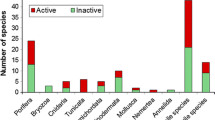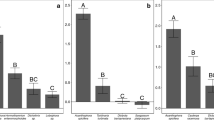Abstract
Numerous opisthobranchs are known to sequester chemical defenses from their prey and use them for their own defense. Information on feeding biology is critical for understanding the ecology and evolution of molluscs, yet information on feeding biology is still scarce for many groups. Gastropterid molluscs are often found on sponges, but there is controversy as to whether they are true sponge feeders. On Guam, we found the gastropterids Sagaminopteron nigropunctatum and S. psychedelicum on the sponge Dysidea granulosa. They seem to rely on contrasting defense strategies as S. psychedelicum has vivid colors, consistent with the warning coloration found in many chemically defended opisthobranchs, whereas S. nigropunctatum is highly cryptic on the sponge. S. nigropunctatum is avoided by the pufferfish Canthigaster solandri in aquarium assays. We analyzed the secondary metabolites of the two species and found that both share polybrominated diphenyl ethers (BDEs) with their host sponge D. granulosa. S. psychedelicum and S. nigropunctatum sequester the major BDE in the sponge and accumulate it in the mantle at approximately the same concentration as in the sponge (4.03 and 2.37%, respectively), and concentrate it in their parapodia at over twice the sponge concentration (7.97 and 10.10%, respectively). We also detected trace amounts in the mucus secretion of S. psychedelicum, and quantified significant amounts in the mucus (1.84%) and egg masses (2.22%) of S. nigropunctatum. Despite contrasting color patterns displayed by the two gastropterid species, they seem to share a similar chemical defense strategy, i.e., they feed on D. granulosa and accumulate the major BDE of the sponge in their tissues.

Similar content being viewed by others
References
Avila, C. 1995. Natural products of Opisthobranch molluscs. Oceanogr. Mar. Biol. Annu. Rev. 33:487–559.
Avila, C. and Paul, V. J. 1997. Chemical ecology of the nudibranch Glossodoris pallida: Is the location of diet-derived metabolites important for defense? Mar. Ecol. Prog. Ser. 150:171–180.
Becerro, M. A. and Paul, V. J. 2004. Effects of depth and light on secondary metabolites and cyanobacterial symbionts of the sponge Dysidea granulosa. Mar. Ecol. Prog. Ser. 280:115–128.
Becerro, M. A., Goetz, G., Paul, V. J., and Scheuer, P. J. 2001. Chemical defenses of the Sacoglossan mollusk Elysia rufescens and its host alga Bryopsis sp. J. Chem. Ecol. 27:2287–2299.
Becerro, M. A., Turon, X., Uriz, M. J., and Templado, J. 2003. Can a sponge feeder be a herbivore? Tylodina perversa (Gastropoda) feeding on Aplysina aerophoba (Demospongiae). Biol. J. Linn. Soc. 78:429–438.
Burn, R. and Bell, K. N. 1974a. Description of Retusa chrysoma Burn sp. nov. (Opisthobranchia) and its food resources from Corner Inlet, Victoria. Mem. S. Nat. Mus. Vict. 35:115–119.
Burn, R. and Bell, K. N. 1974b. Description of Retusa pelyx Burn sp. nov. (Opisthobranchia) and its food resources from Swan Bay, Victoria. J. Malacol. Soc. Aust. 3:37–42.
Calado, G. and Urgorri, V. 2002. A new species of Calma Adler & Hancock, 1855 (Gastropoda: Nudibranchia) with a review of the genus. J. Molluscan Stud. 68:311–317.
Carlson, C. H. and Hoff, P. J. 1973. Two new species of Gasteropteridae from Guam, Mariana Islands (Opisthobranchia: Cephalaspidea). Publ. Seto Mar. Biol. Lab. 21:141–152.
Carlson, C. H. and Hoff, P. J. 1974. The Gasteropteridae of Guam, with descriptions of four new species (Opisthobranchia: Cephalaspidiea). Publ. Seto Mar. Bio. Lab. 21:345–363.
Carpenter, R. C. 1986. Partitioning herbivory and its effects on coral reefs algal communities. Ecol. Monogr. 56:345–365.
CartÉ, B. and Faulkner, D. J. 1983. Defensive metabolites from three nembrothid nudibranchs. J. Org. Chem. 48:2314–2318.
CartÉ, B. and Faulkner, D. J. 1986. Role of secondary metabolites in feeding associations between a predatory nudibranch, 2 grazing nudibranchs, and a bryozoan. J. Chem. Ecol. 12:795–804.
Cimino, G. and Ghiselin, M. T. 1998. Chemical defense and evolution in the Sacoglossa (Mollusca: Gastropoda: Opisthobranchia). Chemoecology 8:51–60.
Cimino, G. and Ghiselin, M. T. 1999. Chemical defense and evolutionary trends in biosynthetic capacity among dorid nudibranchs (Mollusca: Gastropoda: Opisthobranchia). Chemoecology 9:187–207.
Cimino, G., Fontana, A., and Gavagnin, M. 1999. Marine opisthobranch molluscs: Chemistry and ecology in sacoglossans and dorids. Curr. Org. Chem. 3:327–372.
Cimino, G., Ciavatta, M. L., Fontana, A., and Gavagnin, M. 2001. Metabolites of marine opisthobranchs: Chemistry and biological activity, pp. 577–637, in C. Tringali (ed.). Bioactive Compounds from Natural Sources. Taylor & Francis, London.
Duffy, J. E. and Paul, V. J. 1992. Prey nutritional quality and the effectiveness of chemical defenses against tropical reef fishes. Oecologia 90:333–339.
Ebel, R., Marin, A., and Proksch, P. 1999. Organ-specific distribution of dietary alkaloids in the marine opisthobranch Tylodina perversa. Biochem. Syst. Ecol. 27:769–777.
Endler, J. A. 1978. A predator's view of animal color patterns. Evol. Biol. 11:319–364.
Edmunds, M. 1991. Does warning coloration occur in nudibranchs? Malacologia 32:241–255.
Elyakov, G. B., Kuznetsova, T., Mikhailov, V. V., Maltsev, I. I., Voinov, V. G., and Fedoreyev, S. A. 1991. Brominated diphenyl ether from a marine bacterium associated with the sponge Dysidea sp. Experientia 47:632–633.
Faulkner, D. J. 1992. Chemical defenses of marine molluscs, pp. 119–163, in V. J. Paul (ed.). Ecological Roles of Marine Natural Products. Comstock Publishing Associates, Ithaca, NY.
Faulkner, D. J. and Ghiselin, M. T. 1983. Chemical defense and the evolutionary ecology of dorid nudibranchs and some other opisthobranch gastropods. Mar. Ecol. Prog. Ser. 13:295–301.
Faulkner, D. J., Harper, M. K., and Haygood, M. G. 2000. Symbiotic bacteria in sponges: Sources of bioactive substances, pp. 107–119, in Fusetani (ed.) Drugs from the Sea. Karger, Basel.
Fu, X., Schmitz, J., Govindan, M., and Abbas, S. A. 1995. Enzyme inhibitors: New polybrominated phenols and diphenyl ethers from four Indo-Pacific Dysidea sponges. J. Nat. Prod. 58:1384–1391.
Gosliner, T. M. 2001. Aposematic coloration and mimicry in opisthobranch mollusks: New phylogenetic and experimental data. Boll. Malacol. 37:163–170.
Handayani, D., Edrada, R. A., Proksch, P., Wray, V., Witte, L., Van Soest, R. W. M., Kunzmann, A., and Soedarsono. 1997. Four new bioactive polybrominated diphenyl ethers of the sponge Dysidea herbacea from west Sumatra, Indonesia. J. Nat. Prod. 60:1313–1316.
Hurst, A. 1965. Studies on the structure and function of the feeding apparatus of Philine aperta with a comparative consideration of some other opisthobranchs. Malacologia 2:281–347.
Johnson, P. M. and Willows, A. O. D. 1999. Defense in sea hares (Gastropoda, Opisthobranchia, Anaspidea): Multiple layers of protection from egg to adult. Mar. Freshw. Behav. Physiol. 32:147–180.
Kelly, M., Hooper, J., Paul, V. J., Paulay, G., Van Soest, R., and De Weerdt, R. 2003. Taxonomic inventory of the sponges (Porifera) of the Mariana Islands. Micronesica 35–36:100–120.
Kohn, A. J. 1983. Feeding biology of gastropods, pp. 1–63, in A. S. M. Saleuddin and K. M. Wilbur (eds.). The Mollusca, 5. Physiology, Part 2. Academic Press, New York.
Lowe-McConnell, R. H. 1987. Ecological Studies in Tropical Fish Communities. Cambridge University Press, New York, NY.
Matsunaga, S., Fusetani, N., Hashimoto, K., Koseki, K., and Noma, M. 1986. Kabiramide C, a novel antifungal macroclide from nudibranch eggmasses. J. Am. Chem. Soc. 108:847–849.
Megina, C. and Cervera, J. L. 2003. Diet, prey selection and cannibalism in the hunter opisthobranch Roboastra europea. J. Mar. Biol. Assoc. UK 83:489–495.
Mikkelsen, P. M. 1996. The evolutionary relationships of the Cephalaspidea S.L. (Gastropoda, Opisthobranchia) with an analysis of traditional Cephalaspid characters. Boll. Malacol. 29:15–138.
Morrow, C. C., Thorpe, J. P., and Picton, B. E. 1992. Genetic divergence and cryptic speciation in two morphs of the common subtidal nudibranch Doto coronata (Opisthobranchia: Dendronotacea: Dotoidae) from the northern Irish Sea. Mar. Ecol. Prog. Ser. 84:53–61.
Paul, V. J., Lindquist, N., and Fenical, W. 1990. Chemical defenses of the tropical ascidian Atapozoa sp. and its nudibranch predators Nembrotha spp. Mar. Ecol. Prog. Ser. 59:109–118.
Pawlik, J. R., Kernan, M. R., Molinski, T. F., Harper, M. K., and Faulkner, D. J. 1988. Defense chemicals of the Spanish dancer nudibranch Hexabranchus sanguineus and its egg ribbons: Macrolides derived from a sponge diet. J. Exp. Mar. Biol. Ecol. 119:99–109.
Pennings, S. C. and Paul, V. J. 1993. Secondary chemistry does not limit dietary range of the specialist sea hare, Stylocheilus longicauda (Quoy et Gaimard 1824). J. Exp. Mar. Biol. Ecol. 174:97–113.
Pennings, S. C., Pablo, S. R., Paul, V. J., and Duffy, J. E. 1994. Effects of sponge secondary metabolites in different diets on feeding by three groups of consumers. J. Exp. Mar. Biol. Ecol. 180:137–149.
Poulton, E. B. 1890. The Colours of Animals. Their Meaning and Use, Especially Considered in the Case of Insects. Keegan Paul, Trench, Trübner & Co., London.
Rudman, W. B. 1981. Further studies on the anatomy and ecology of opisthobranch molluscs feeding on the scleractinian coral Porites. Zool. J. Linn. Soc. 71:373–412.
Sharma, G. M. and Vig, B. 1972. Studies on the antimicrobial substances of sponges. VI. Structures of two antibacterial substances isolated from the marine sponge Dysidea herbacea. Tetrahedron Lett. 17:1715–1718.
Shonman, D. and Nybakken, J. W. 1978. Food preference, food availability and food resource partitioning in two sympatric species of cephalaspidean opisthobranchs. Veliger 21:120–126.
Sokal, R. R. and Rohlf, F. J. 1995. Biometry. The Principles and Practice of Statistics in Biological Research. Freeman, New York, USA.
Teeyapant, R., Woerdenbag, H. J., Kreis, P., Hacker, J., Wray, V., Witte, L., and Proksch, P. 1993. Antibiotic and cytotoxic activity of brominated compounds from the marine sponge Verongia aerophoba. Z. Naturforsch. 48:939–945.
Thacker, R. W. and Starnes, S. 2003. Host specificity of the symbiotic cyanobacterium Oscillatoria spongeliae in marine sponges, Dysidea spp. Mar. Biol. 142:643–648.
Thompson, T. E. and Brown, G. H. 1984. Biology of Opisthobranch Molluscs, Vol. II. The Ray Society, London.
Unson, M. D., Holland, N. D., and Faulkner, D. J. 1994. A brominated metabolite by the cyanobacterial symbiont of a marine sponge and accumulation of the crystalline metabolite in the sponge tissue. Mar. Biol. 119:1–11.
Voinov, V. G., Elkin, Y. N., Kuznetsova, T. A., Maltsev, I. I., Mikhailov, V. V., and Sasunkevich, V. A. 1991. Use of mass spectrometry for the detection and identification of bromine-containing diphenyl ethers. J. Chromatogr. 586:360–362.
Wallace, A. R. 1867. Mimicry and other protective resemblances among animals. Westminster Rev. 32:1–43.
Willan, R. C. 1984. A review of diets in the Notaspidea (Mollusca: Opisthobranchia). J. Malacol. Soc. Aust. 6:125–142.
Williams, S. I. and Walker, D. I. 1999. Mesoherbivore–macroalgal interactions: Feeding ecology of sacoglossan sea slugs (Mollusca, Opisthobranchia) and their effects on their food algae. Oceanogr. Mar. Biol. Annu. Rev. 37:87–128.
Acknowledgments
This study was supported by a grant from the Guam Shell Club to J.A.S. and NIH grants GM38624 and GM44796 to V.J.P. Raphael Ritson-Williams, Lucas Cervera, and two anonymous reviewers made useful comments on earlier versions of this manuscript. Lee-Ann Hayek provided advice on statistical analyses. This is contribution no. 575 of the University of Guam Marine Laboratory and contribution no. 615 of the Smithsonian Marine Station at Fort Pierce.
Author information
Authors and Affiliations
Corresponding author
Rights and permissions
About this article
Cite this article
Becerro, M.A., Starmer, J.A. & Paul, V.J. Chemical Defenses of Cryptic and Aposematic Gastropterid Molluscs Feeding on their Host Sponge Dysidea granulosa . J Chem Ecol 32, 1491–1500 (2006). https://doi.org/10.1007/s10886-006-9064-5
Received:
Revised:
Accepted:
Published:
Issue Date:
DOI: https://doi.org/10.1007/s10886-006-9064-5




